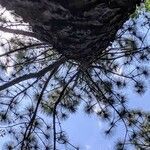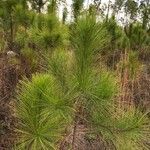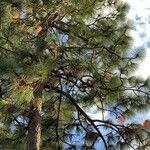Trees to 45 m tall; trunk to 1.2 m d.b.h. in native range; bark orange-brown, with coarse, oblong, scaly plates; crown rounded; branches spreading-descending, upcurved at tips; branchlets orange-brown, aging darker brown, stout, rough; winter buds silvery white, ovoid, 3-4 cm, scales fringed at margin. Needles spreading-recurved, (2 or)3 per bundle, yellow-green, slightly twisted, 20-45 cm × ca. 1.5 mm, stomatal lines present on all surfaces, base with persistent sheath 2-2.5(-3) cm, margin finely serrulate. Seed cones solitary or paired toward branchlets tips, sessile or rarely shortly pedunculate, dark brown, ovoid-cylindric when open, 15-25 cm, maturing in 2 years, then quickly shedding seeds and falling. Apophyses dull, nearly rhombic, slightly thickened and raised, strongly cross keeled; umbo broadly triangular, with a short, stiff, reflexed prickle. Seeds pale brown, mottled darker, truncate-obovoid, ca. 1 cm; wing 3-4 cm.
Tall tree, to 30 m; bark becoming orange-brown, with rough, scaly plates; twigs very stout; winter buds large, to 2.5 cm, covered with silvery-white, fringed scales; lvs in 3’s, closely crowded at the ends of the branches, persistent 2 years, light green, soft, often drooping, 20–30(–50) cm; cones divergent, often pendent, conic-oblong, 15–25 x 5–6 cm, opening at maturity and soon falling; apophysis thick and prominently ridged, the umbo elevated, with a small, reflexed spine; seeds ca 4 cm. Moist or dry, sandy soil, largely on the coastal plain, less commonly on the piedmont; se. Va. to Fla. and Tex. (P. australis F. Michx., an illegitimate substitute name)
A tall pine tree. It grows 40 m tall. The trunk can be 1.2 m across. The bark is orange-brown and in coarse rectangular plates. The leaves are needle like and 20-45 cm long by 1.5 mm wide. They are shiny and slightly twisted. They are in bundles of 2-3. The male cones are cylinder shaped and 3-8 cm long. The female cones are 15-25 cm long. The seeds are 10 mm long.





